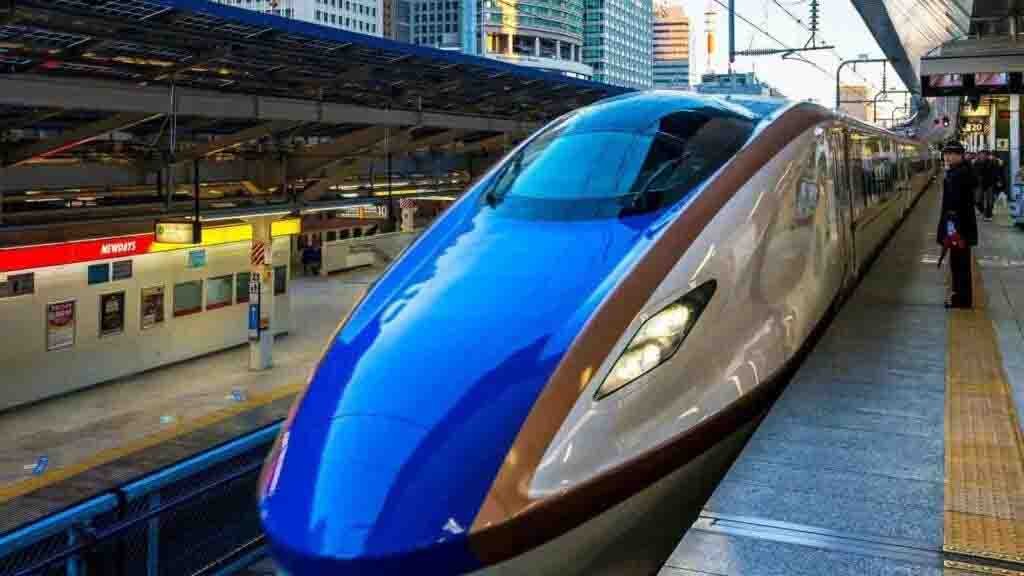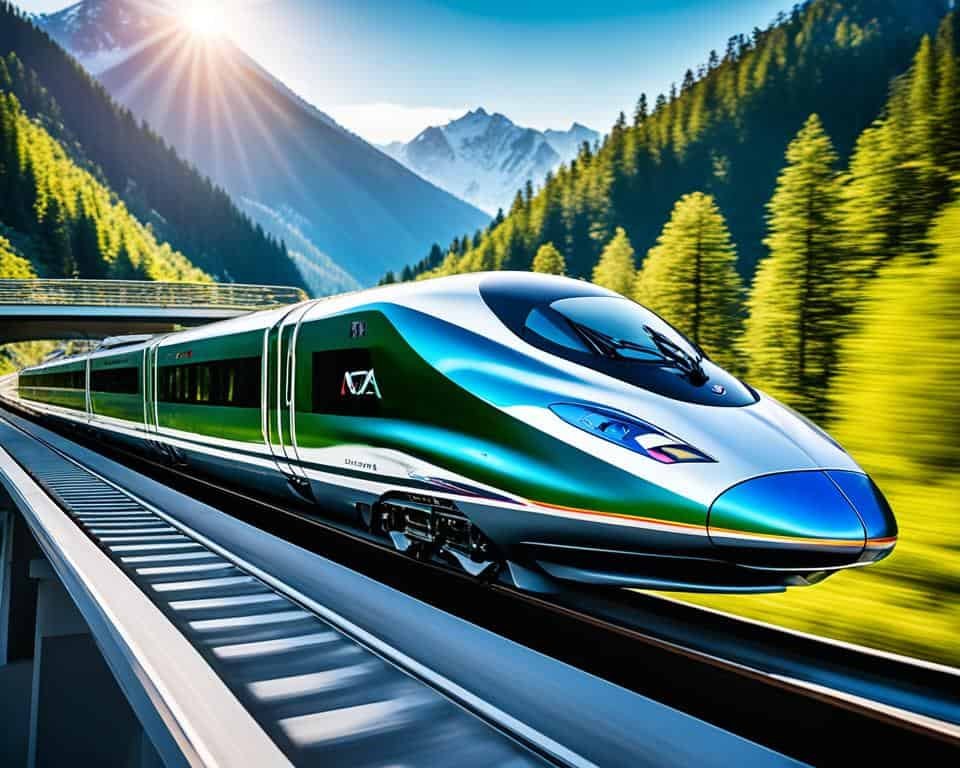
In 1964, Japan introduced the Shinkansen or bullet trains. These trains quickly became famous for their high-speed travel. They were more than just a new way to move around. They signaled Japan’s revival after a difficult period in history.
Key Takeaways
- The Shinkansen revolutionized the concept of train travel with its introduction in 1964, propelling Japan onto the world stage of technological advancement.
- Japan’s bullet trains exemplify groundbreaking railway technology that has become integral to the nation’s image of high-speed travel and efficiency.
- With a historical launch coinciding with the Tokyo Olympics, the Shinkansen showcased Japan’s economic and technological revival following World War II.
- The seamless Tokyo to Osaka route by the Shinkansen marked an era where distance succumbed to speed, redefining the experience of intercity travel.
- A testament to continued innovation, the Shinkansen remains a global benchmark in the realm of modern transportation systems.
The Birth of Shinkansen and its Historical Significance
In 1964, the Shinkansen had its first journey from Tokyo to Osaka. It was not just about fast travel. This event showed how Japan was moving quickly from war to modern life with new technology.
The Inaugural Ride: Tokyo to Osaka
The Shinkansen from Tokyo to Osaka was a big deal. It showed Japan’s hard work and smart planning. Being the first of its kind, it changed what people thought trains could do.
Symbol of Japan’s Post-War Recovery
The Shinkansen was more than a train. It showed the world that Japan was strong again after World War II. It proved Japan’s ability to make big things and lead in tech and new ideas.
1964 Tokyo Olympics and the Global Stage
The 1964 Tokyo Olympics and the Shinkansen happened in the same year. The Shinkansen was a star, showing the world Japan’s bright future. It proved Japan was back, better than ever.
Shinkansen: A Byword for Speed and Efficiency
The Shinkansen is Japan’s famous bullet train. It stands for fast and efficient travel. For over fifty years, it has set new standards in high-speed rail, traveling at up to 200 mph. Its impact on worldwide rail travel is huge.
Expansion of the Network
The Shinkansen’s network shows how strong and efficient it is. It started with a 320-mile path. Now, it connects many important cities like Kobe, Kyoto, and Hiroshima in Japan. This makes traveling across Japan fast and easy.
Innovations in Speed: Up to 200 mph
The Shinkansen is always trying to be faster. It can reach speeds of 200 mph. This not only makes trips shorter but also shows Japan’s skill in using fast trains for better travel for everyone.
Shinkansen’s Influence on Rail Technology Worldwide
The Shinkansen’s technology has spread worldwide. Many countries have followed their lead in high-speed rail. This shows how the Shinkansen has changed rail travel all over the world.
Technology and Design of Bullet Trains
The Shinkansen, known as bullet trains, blend tradition and modern tech perfectly. They push the limits of train and aerodynamic design. The ALFA-X is the latest achievement in bullet train tech.
The Unique Gauge of Japan’s Railways
The Shinkansen uses a special gauge to improve speed and stability. This gauge is narrower than others worldwide. It helps the trains go faster and smoother.
Breaking the Sound Barrier: Shinkansen’s Aerodynamics
The Shinkansen’s shape is carefully crafted for minimal air resistance. This design reduces the loud noise high-speed trains usually make. It lets the trains run near homes quietly.
ALFA-X: Pushing the Future of High-Speed Rail
The ALFA-X is the most advanced Shinkansen model. It can reach speeds of 250 mph while keeping passengers comfortable. Its long nose, about 22 meters, helps it during high-speed trips.

The Shinkansen, with its special gauge, aerodynamics, and models like the ALFA-X, leads high-speed rail. It’s a symbol of fast, innovative, and safe travel for the future.
Perfect Safety Record: Shinkansen’s Commitment to Passenger Security
The bullet train is known for its top-notch safety. It serves Japan’s varied and sometimes dangerous land with no fatal accidents. This perfect record shows the care in making every journey safe.
The bullet train is the vital part of Japan’s trains. It stands out for its safety thanks to great train design and well-trained staff. Even Japan’s earthquakes are considered with special safety features. This makes the Shinkansen a leader in train safety.
- Continuous monitoring and maintenance ensure the integrity of the tracks and trains.
- Highly trained staff ready to manage any situation with precision.
- Advanced technological systems that automatically reduce speed and stop the train in case of an emergency.
The bullet train offers quick travel across Japan while keeping passengers safe. This focus on safety has won over the trust of many who use it, from daily commuters to tourists.
Shinkansen: Pillar of Economic and Social Transformation
The bullet train, Japan’s high-speed rail, has greatly shaped the nation’s story. It boosts the economy and brings people together. It does much more than just move people from place to place.
Boosting Japan’s Economic Development
The bullet train is a key player in Japan’s big growth. It’s fast, moving goods and people quickly across the country. This has spread business activities more widely, making growth more even.
Integration and Convention: Influencing Japanese Culture
It is more than just fast travel. The bullet train combines old traditions with new tech, reflecting Japan’s rich culture. It creates pride and togetherness among the people. It’s not just for going to work; it also brings folks together during special times.

Overcoming Geographical and Environmental Challenges
The bullet train system is truly amazing. It overcomes tough geographical and environmental challenges. It runs through lands filled with different terrains and faces strong weather. Despite earthquakes and tsunamis, this high-speed rail network shows its strength.
Japan’s Topography: Tunnels and Bridges
The bullet train stands out with its smart use of tunnels and bridges. They help the train cross Japan’s mountains and big water areas. By doing this, the train joins faraway places with big cities. It makes travel easier and helps the economy.
Enduring Harsh Climates: From Snow to Tropical Humidity
The bullet train deals with everything from snow in the north to high humidity in the south well. This shows how carefully planned and high-tech the system is. Its people stay safe and on time, no matter the weather.
Building Resilience Against Earthquakes and Tsunamis
Japan faces lots of earthquakes and tsunamis. So, the bullet train was built to be tough against these. With special shock absorbers, real-time quake checks, and auto brakes, it stays very safe. It’s one of the most secure train systems, even with many natural disasters.
Environmental Impact and Sustainability of the Shinkansen
The bullet train is not just fast and efficient. It is also a leader in being kind to the environment. With the world looking for more green ways to travel, the bullet train shines. It leads with its green policies and caring for the planet. This makes it a top choice for many.
Comparing Eco-Friendliness: Shinkansen vs. Cars and Planes
The bullet train is kinder to the planet than cars and planes. It uses electricity to run, cutting down on harmful gases. Its design reduces noise and vibrations, which helps in crowded places.
- Eco-friendly: Emits far fewer greenhouse gases than cars or planes.
- Sustainability: Runs on electricity, which can be sourced from renewable energy.
- Reduced noise pollution: Engineered to operate quietly, protecting urban soundscapes.
Implementing Green Policies in Rail Travel
The bullet train works hard to be green. It’s not just the trains but the whole operation. It’s all about caring for the earth.
- Tree planting initiatives are routinely organized to offset the ecological footprint.
- Advanced soundproofing techniques are employed to mitigate environmental noise.
This eco-friendly thinking helps the Shinkansen be more than just a way to travel. It makes the areas it touches better for everyone. This shows its true leadership in eco-conscious travel.
Exporting Shinkansen Technology and Influencing Global Transportation
The Shinkansen’s impact goes far beyond Japan. Its cutting-edge rail tech has changed how we move across the world. It’s not just about fast travel. It’s spurred big growth in many places, improving train systems everywhere.
Japan’s Rail Tech Exports
Japan leads the way in sharing Shinkansen’s tech with the world. Many countries, wanting to do what the Shinkansen does, have welcomed Japan’s help. This sharing has made Japan a top name in rail tech, setting new standards for everyone.
International High-Speed Rail Developments Inspired by the bullet train
From Europe to Asia, you can see the Shinkansen’s mark. France’s TGV, India’s growing high-speed rail, and the big ideas in the United States all look to Japan. These efforts show a global push for faster, better rail, linking us more and more.
Conclusion
The bullet train marks over 50 years of amazing success. It is both a cultural gem and a top tech achievement. It has paved the way for high-speed trains worldwide. Bullet train is more than fast travel; it’s about progress that values nature, works efficiently, and keeps us safe.
These trains have been changing the game in economic growth. They connect Japan’s areas tightly and push this reach to global markets. They’re more than vehicles; they are builders of a connected world. By making travel fast and smooth, they enrich the lives of many.
The bullet train journey never stops. It focuses on sustainable development always. As Japan introduces newer, better models, it inspires the world. This shows how continuous improvement in moving people can lead to a better, greener future. It motivates new minds and changes how we see global travel.
FAQ
What is the Shinkansen?
The Shinkansen is also known as the bullet train. It’s a fast train network in Japan. It travels up to 200 mph.
When did the Shinkansen begin operation?
It started running on October 1, 1964. The first trip was from Tokyo to Osaka.
How did the Shinkansen impact Japan after World War II?
After World War II, the bullet train showed Japan’s recovery. It also showed off new technology. This happened during the 1964 Tokyo Olympics, spotlighting Japan’s global revival.
What makes the Shinkansen different from other high-speed trains in terms of design?
It has its own rail size and design features. The ALFA-X model can reduce sound booms. It also runs very fast.
How safe is the Shinkansen for passengers?
The bullet train is very safe. There have been no accidents that hurt or killed people. This shows they are serious about keeping passengers safe.
What role has the Shinkansen played in Japan’s economic and social development?
The bullet train helped Japan’s economy a lot. It made moving goods and people fast. This spread economic activities all over Japan. It also became a part of the nation’s culture, showing both old and new.
How has the Shinkansen overcome Japan’s geographic challenges?
The bullet train is built to deal with Japan’s tough land and weather. It has many tunnels and bridges. It can withstand earthquakes and tsunamis very well.
Is the Shinkansen environmentally friendly?
Yes, the bullet train is kind to the planet. It’s powered by electricity. It is better for the environment than cars and planes. The train company also works on planting trees and reducing noise.
Has Japan exported Shinkansen technology to other countries?
Japan has shared the bullet train technology with other countries. This has helped start fast train projects worldwide. For example, in France and soon in India and the United States.
What is the significance of the Shinkansen’s legacy?
The Shinkansen has changed how we travel the world. It has set big standards in safety, speed, and being eco-friendly. It has also helped grow the economy and advance technology in Japan and globally.
